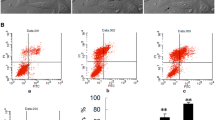Abstract
The antisecretory factor (ASF) is a hormone-like protein (m.w. 60,000) that most effectively counteracts hypersecretion in vivo in the small intestine of pigs and rats. The present report demonstrate that 10−13 moles of ASF inhibits significantly the36Cl− permeation through the isolated neuronal plasma membrane of Deiters' cells in rabbits. This effect was enhanced by 0.2 mM γ-aminobutyric acid (GABA), and quenched by the addition of anti-ASF immunoglobulins; pretreatment of the neuronal membrane with nipecotic acid (10−6 M) or with bicuculline (10−3 M) abolished the ASF action whilst picrotoxin (10−4 M) pretreatment left the inhibitory effect of ASF unaffected. The results suggest that ASF blocks chloride channels in neuronal membranes, including those channels activated by GABA.
Similar content being viewed by others
Abbreviations
- ASF:
-
antisecretory factor
- GABA:
-
γ-aminobutyric acid
- SEM:
-
standard error of the mean
References
Cooke HJ (1986) Neurobiology of the intestinal mucosa. Gastroenterology 90:1057–1081
Cupello A, Hydén H (1981) On the presence of Met 5-enkephalin receptors on the plasma membrane of Deiter's neurons and their modulation of GABA transport. J Neurosci Res 6:579–583
Enna SJ, Gallagher JP (1983) Biochemical and electrophysiological characteristics of mammalian GABA receptors. Int Rev Neurobiol 24:181–206
Fogel R, Kaplan RB, Arbit E (1985) Central action of γ-aminobutyric acid ligands to alter basal water and electrolyte absorption in the rat ileum. Gastroenterology 88:523–530
Hydén H, Cupello A (1987) Inhibition in the mammalian brain. Acta Physiol Scand (Suppl 561) 130:1–77
Hydén H, Lange PW, Larsson S (1980) S-100-glia regulation of GABA-transport across the nerve cell membrane. J Neurol Sci 45:303–316
Hydén H, Cupello A, Palm A (1986) γ-aminobutyric acid stimulates chloride permeability across microdissected Deiter's neuronal membrane. Brain Res 379:167–170
Jessen KR (1981) GABA and the enteric nervous system — a neurotransmitter function? Mol Cell Biochem 38:69–76
Kriger DT, Martin JB (1981) Brain peptides. N Engl J Med 304:876–885
Krogsgaard-Larsen P, Johnston GA (1975) Inhibition of GABA uptake in rat brain slices by nipecotic acid, various isoxazoles and related compounds. J Neurochem 25:797–802
Lange S. Lönnroth I (1984) Passive transfer of protection against cholera toxin in the rat intestine. FEMS Microbiol Letters 24:165–168
Lange S., Lönnroth I (1986) Bile and milk from cholera toxin treated rats contain a hormone-like factor which inhibits diarrhea induced by the toxin. Int Archs Allergy Appl Immunol 79:270–275
Lange S, Lönnroth I, Palm A, Hydén H (1985) An inhibitory protein of intestinal fluid secretion reverses neuronal GABA transport. Biochem Biophys Res Commun 130:1032–1036
Lange S, Lönnroth I, Skadhauge E (1987) Effects of the antisecretory factor in pigs. Pflügers Arch 409:328–332
Lönnroth I, Lange S (1984) Purification and characterization of a hormone-like factor which inhibits cholera secretion. FEBS Lett 177:104–108
Lönnroth I, Lange S (1984) Inhibition of cyclic AMP-mediated intestinal hypersecretion by pituitary extracts from rats pretreated with cholera toxin. Med Biol 62:5:290–294
Lönnroth I, Lange S (1986) Purification and characterization of the antisecretory factor — a protein in the central nervous system and in the gut which inhibits intestinal hypersecretion induced by cholera toxin. Biochim Biophys Acta 883:138–144
Miller J (1985) Control of epithelial ion transport by neuropeptides. Regul Pept 4 (Suppl):203–208
Oberling C, Kallo A (1929) Ulcéres aigus des l'estomac consécutifs a des lésions experimentales des noyaux gris centraux. C R Soc Biol 102:832–833
Olsen RW (1981) GABA-benzodiazepine-barbiturate receptor interactions. J Neurochem 37:1–13
Simmonds MA (1980) Evidence that bicuculline and picrotoxine act at separate sites to antagonize γ-aminobutyric acid in rat cuneate nucleus. Neuropharmacology 19:39–45
Skadhauge E, Lange S, Lönnroth I (1986) Effects of secretagogues and of a pituitary antisecretory factor (ASF) on the Na and Cl fluxes across the pig jejunum in vitro. Prog Int Physiol Sci 16:372
Turner AJ, Whittle SR (1983) Biochemical dissection of the γ-aminobutyrate-synapse. Biochem J 209:29–41
Author information
Authors and Affiliations
Rights and permissions
About this article
Cite this article
Lange, S., Lönnroth, I., Palm, A. et al. The effect of antisecretory factor on the permeability of nerve cell membrane to chloride ion. Pflugers Arch. 410, 648–651 (1987). https://doi.org/10.1007/BF00581326
Received:
Revised:
Accepted:
Issue Date:
DOI: https://doi.org/10.1007/BF00581326




